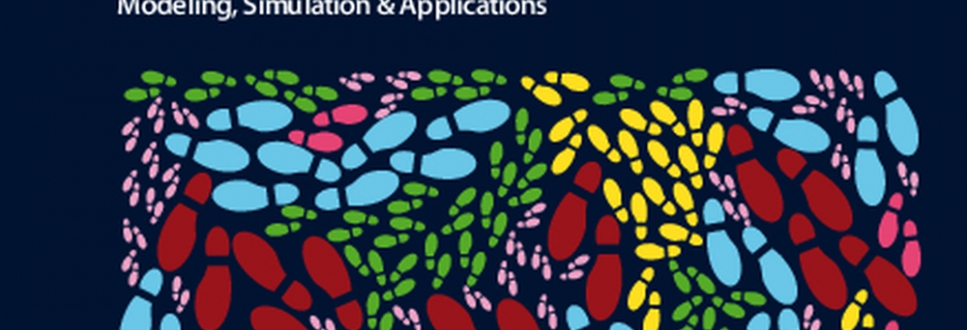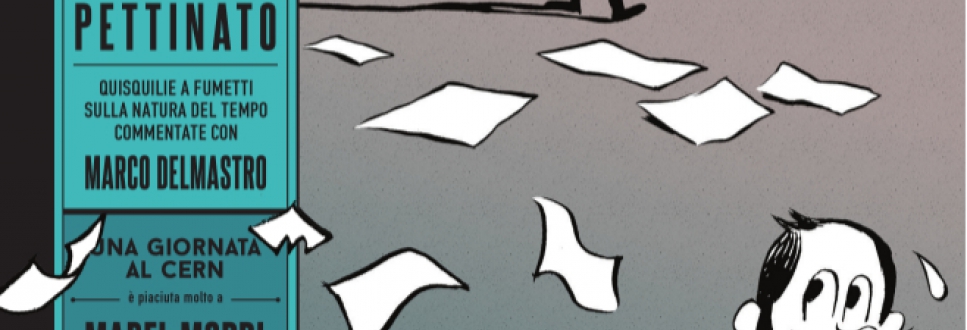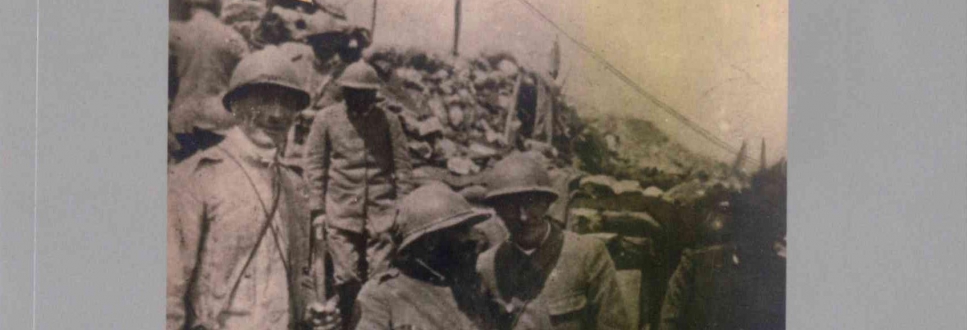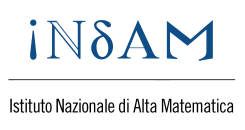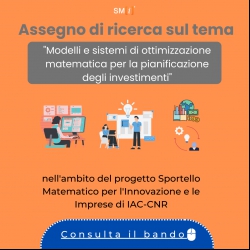
Notiziario dei Seminari di Matematica a Roma -- Settimana dal 19 al 25 novembre 2012
2012-11-25
Notiziario dei Seminari di Matematica a Roma -- Settimana dal 19 al 25 novembre 2012, a cura del DIPARTIMENTO DI MATEMATICA, UNIVERSITA' DI ROMA "LA SAPIENZA".
Lunedi' 19 novembre 2012
Ore 14:30, Aula di Consiglio
Seminario di Analisi Matematica
Juan Casado (Universita' di Siviglia)
Homogenization and correctors for the wave equation
We study the asymptotic behavior of a wave problem with periodic
coefficients in the space variable and almost periodic coefficients in
the time one. Contrary to the classical result for elliptic or
parabolic problems, we prove that the corrector is non-local. Adding
terms of first order in the equation, we show that the limit problem
is in general non-local.
Lunedi' 19 novembre 2012
Ore 16:00, Aula di Consiglio
Seminario di Probabilita'
Massimiliano Gubinelli (Universita' di Paris-Dauphine)
Controlled distributions
Rough path theory is a robust way to define integrals wrt irregular
objects, like the paths of stochastic processes. In this way it is
possible to overcome some difficulties with the standard Integral. For
example it allows to define and solve differential equations driven by
non-semimartingale stochastic processes. In this talk I will explain
how it is possible to extend the ideas of rough paths to the much more
general setting of non-linear operations over stochastic
multi-dimensional distributions. As an application I will discuss how
to give meaning and show existence of solutions for two class of
SPDEs: Burgers like equations on the d-dimensional torus and a
parabolic anderson model in two-dimensions.
Martedi' 20 novembre 2012
Ore 14:30, Aula Dal Passo, Universita' di Roma II
Seminario di Equazioni Differenziali
Shusen Yan (University of New England, Australia)
Bubbling solutions for the SU(3) Chern-Simons model on a torus
Martedi' 20 novembre 2012
Ore 15:00, Aula di Consiglio
Seminario di Modellistica differenziale numerica
Stefano Finzi Vita (Universita' di Roma I)
A semi-Lagrangian scheme for the game p-Laplacian
We present and analyze a numerical approximation of the
two-dimensional Dirichlet problem for the game p-Laplacian based on a
semi-Lagrangian scheme. We start from recalling the definition of game
p-Laplacian, which has been recently introduced by Peres and Sheffield
to model the continuous limit value of certain stochastic games
(tug-of-war with noise). In the homogeneous case (no right-hand side),
variational and game p-Laplacian operators are essentially the same,
but in the general case the variational structure of the problem is no
more available. The key tool for our approximation scheme is then the
discretization of the p-operators in terms of p-averages of a finite
number of values. We study the property of the scheme and prove that
it converges, under certain hypotheses, to the viscosity solution of
the game p-Laplacian problem. Then we present a number of numerical
tests to show that the scheme is accurate. (Joint work with M.
Falcone, T. Giorgi and R.G. Smits)
Mercoledi' 21 novembre 2012
Ore 14:00, Aula B
Corso di Dottorato
Gerard Letac (Universita' di Toulouse)
Dirichlet random probabilities and applications, prima lezione
Mercoledi' 21 novembre 2012
Ore 14:30, Aula di Consiglio
Seminario di Algebra e Geometria
Edoardo Sernesi (Universita' di Roma III)
La coomologia locale dell'anello jacobiano
E' un fatto classico che l'anello jacobiano di una ipersuperficie
proiettiva nonsingolare sia un oggetto molto semplice che contiene
informazioni geometriche e algebriche interessanti. Nel caso singolare
la situazione e' piu' complicata, ma faro' vedere che molte proprieta'
si estendono se si sostituisce l'anello jacobiano con il suo spazio di
coomologia locale di grado zero.
Mercoledi' 21 novembre 2012
Ore 16:00, Aula F, Universita' di Roma III
I te' di matematica
Roberto di Pietro
Tecniche di autenticazione
Giovedi' 22 novembre 2012
Ore 14:00, Aula D'Antoni, Universita' di Roma II
Dynamical Systems working seminars
Tanya Yarmola (Universita' di Ginevra)
Sub-exponential mixing rates for open systems with interacting
particles
Rigorous derivations of macroscopic heat conduction laws from the
microscopic dynamics of mechanical particle systems coupled to heat
reservoirs require good mixing properties of the stationary
distributions. For many such systems in nonequilibrium, i.e., with two
or more unequal heat reservoirs, the proof of the mere existence of
stationary distributions is nontrivial due to the non-compactness of
the phase space. It is relatively easy to envision scenarios under
which particles slow down (freezing) or speed up (heating), which may
push initial distributions towards zero or infinite energy levels and
ultimately violate convergence. We consider a class of mechanical
systems in which particles interact with an 'energy tank' represented
by a rotating disk anchored at the center. Particles move freely
between collisions. When a particle collides with the disk, an energy
exchange occurs, in which the particle exchanges the tangential
component of its velocity with the angular velocity of the disk and
the normal component of the particle's velocity changes sign. A system
in this class is coupled to heat reservoirs set at possibly different
temperatures that absorb particles when they collide with the
boundaries of the reservoirs and emit new particles according to the
Gibb's distribution corresponding to the temperatures of the
reservoirs. We show that a stationary distribution exists, is unique,
and is absolutely continuous with respect to the Lebesgue measure. In
addition, all initial distributions converge to the stationary
distribution and a large subclass of initial distributions does so at
sub-exponential rates. The sub-exponential rates of convergence are
primarily due to the influence of slow particles on the system.
Giovedi' 22 novembre 2012
Ore 14:30, Aula L
F. Cerocchi (Universita' di Roma I)
Un lemma di Margulis per prodotti liberi
Mostreremo un Lemma di Margulis a' la Besson Courtois Gallot, per
varieta' il cui gruppo fondamentale e' un prodotto libero non banale
A*B, senza 2-torsione. Inoltre, nel caso in cui A*B sia del tutto
privo di torsione forniremo un limite inferiore per la sistole
omotopica in termini del diametro e dell'entropia volumica. Daremo
alcuni esempi e controesempi per mostrare l'ottimalita' delle nostre
ipotesi. Infine daremo due applicazioni di tale risultato (nello
specifico un teorema di finitezza ed una stima del volume senza
ipotesi di curvatura). Questa ricerca fa parte del mio lavoro di tesi,
svolto sotto la direzione dei professori A. Sambusetti e S. Gallot.
Giovedi' 22 novembre 2012
Ore 14:30, Aula 211, Universita' di Roma III
Seminario di Geometria
Giovanni Mongardi (Universita' di Roma III)
Varieta' Hyperkahler e loro automorfismi
Le varieta' Hyperkahler costituiscono una famiglia di varieta' con
interessanti proprieta' analitiche ed algebriche. Daro' una panoramica
di alcune di esse e mostrero' come possano essere utilizzate per
studiare i gruppi finiti di automorfismi su tali varieta'.
Giovedi' 22 novembre 2012
Ore 14:30, Aula di Consiglio
Seminario P(n): Problemi differenziali non lineari
Shusen Yan (University of New England, Australia)
Solutions concentrating at curves for super-critical elliptic problems
I will present the results on the existence of infinitely many
positive solutions for some elliptic problems with super critical
growth. These results are proved by constructing solutions
concentrating at large number of curves. Some partial symmetry
conditions are needed to obtain such solutions. This is a joint work
with Musso and Wei.
Giovedi' 22 novembre 2012
Ore 15:30, Aula L
F. Bei (Universita' di Roma I)
Dualita' di Poincare' e teoremi di tipo L^2 de Rham-Hodge su
pseudovarieta' stratificate
Sia X una pseudovarieta' stratificata compatta. Sulla sua parte
regolare consideriamo una metrica riemanniana g di tipo quasi-edge con
pesi. Nel seminario verra' mostrato che a tale metrica e' possibile
associare due perversita', p_g e q_g, in modo tale che valgano i
seguenti isomorfismi: 1) La coomologia d'intersezione di X associata a
p_g e' isomorfa alla coomologia di de Rham L^2 minimale associata a g
la quale a sua volta e' isomorfa alla coomologia di Hodge relativa
associata a g. 2) La coomologia d'intersezione di X associata a q_g e'
isomorfa alla coomologia di de Rham L^2 massimale associata a g la
quale a sua volta e' isomorfa alla coomologia di Hodge assoluta
associata a g. Infine verra' mostrato come, partendo dai complessi di
de Rham L^2 minimale e massimale, sia possibile costruire un terzo
complesso L^2 di de Rham che soddisfi la dualita' di Poincare' e la
cui coomologia sia isomorfa all'immagine della coomologia
d'intersezione associata a p_q nella coomologia d'intersezione
associata a q_g. Questa ricerca fa parte del mio lavoro di tesi,
svolto sotto la direzione del prof. P. Piazza.
Giovedi' 22 novembre 2012
Ore 16:00, Aula De Blasi, Universita' di Roma II
Corso di Dottorato
Leandro Arosio (Universita' di Roma II)
Holomorphic dynamics
This course is an introduction to the theory of holomorphic
automorphisms of the complex space C^n, with particular emphasis on
Anderse'n-Lempert theory. It is well-known that for n=1 every
holomorphic automorphism is of the form f(z)=az+b, with a different
from 0. The situation is completely different in several complex
variables, indeed aut(C^n) is a huge and complicated group for all n >
1. Here follows a list of topics that will be considered during the
course. 1) Fatou-Bieberbach domains. If n > 1 there exists proper
domains of C^n biholomorphic to C^n. This kind of domains appear in
particular as basins of an attractive fixed point for an automorphism
of C^n which admits at least another fixed point. The proof is based
on the Poincare'-Dulac method. 2) The Andersen-Lempert theorem. If n >
1 and f is a biholomorphism between a starlike domain and a Runge
domain of C^n, then f is the uniform limit on compact subsets of
automorphisms of C^n. 3) Forstneric-Weickert theorem. Let P: C^n ->C^n
be a polynomial mapping with dP(0) invertible. Let d be the biggest
degree of its components. Then there exists an automorphism F of C^n
such that the d-jet of F at 0 equals P. 4) Construction of a non-Runge
Fatou-Bieberbach domain and of a non-Stein long C^2.
Venerdi' 23 novembre 2012
Ore 12:00, Aula di Consiglio
Seminari MoMa
I. Giardina
Birds, spins and entropy: a theoretical physics approach to collective
animal behaviour
Flocking is a paradigmatic example of self-organized collective
behaviour, where collective ordering emerges from the mutual
interactions between individuals. In this respect, it shares striking
similarities with collective phenomena in inanimate systems that have
long been studied by the physics community. Still, biological systems
are more complicated than physical ones and it is not evident whether
they can be described by the same kind of general laws so well
understood in physics. Experimental findings often go beyond simple
expectations, making this field even more fascinating. In this talk I
will discuss our attempts to study collective animal behaviour using
a physicist's perspective. I will show how we used concepts and
methods from statistical physics to make sense of experimental data of
large flocks of birds. In particular, I will focus on the velocity
correlation functions, that well capture the balance between consensus
and independence among the large number of individuals in the group.
We measured these correlations in real flocks of starlings and found
that they exhibit a non-trivial scale-free behavior, indicating a
surprisingly large degree of coordination and collective response. I
will describe how we can use these correlations to systematically
address the inverse problem, extract from the experimental
measurements information on the underlying microscopic interactions,
and build minimal (maximum entropy) models directly from the data.

Ore 14:30, Aula di Consiglio
Seminario di Analisi Matematica
Juan Casado (Universita' di Siviglia)
Homogenization and correctors for the wave equation
We study the asymptotic behavior of a wave problem with periodic
coefficients in the space variable and almost periodic coefficients in
the time one. Contrary to the classical result for elliptic or
parabolic problems, we prove that the corrector is non-local. Adding
terms of first order in the equation, we show that the limit problem
is in general non-local.
Lunedi' 19 novembre 2012
Ore 16:00, Aula di Consiglio
Seminario di Probabilita'
Massimiliano Gubinelli (Universita' di Paris-Dauphine)
Controlled distributions
Rough path theory is a robust way to define integrals wrt irregular
objects, like the paths of stochastic processes. In this way it is
possible to overcome some difficulties with the standard Integral. For
example it allows to define and solve differential equations driven by
non-semimartingale stochastic processes. In this talk I will explain
how it is possible to extend the ideas of rough paths to the much more
general setting of non-linear operations over stochastic
multi-dimensional distributions. As an application I will discuss how
to give meaning and show existence of solutions for two class of
SPDEs: Burgers like equations on the d-dimensional torus and a
parabolic anderson model in two-dimensions.
Martedi' 20 novembre 2012
Ore 14:30, Aula Dal Passo, Universita' di Roma II
Seminario di Equazioni Differenziali
Shusen Yan (University of New England, Australia)
Bubbling solutions for the SU(3) Chern-Simons model on a torus
Martedi' 20 novembre 2012
Ore 15:00, Aula di Consiglio
Seminario di Modellistica differenziale numerica
Stefano Finzi Vita (Universita' di Roma I)
A semi-Lagrangian scheme for the game p-Laplacian
We present and analyze a numerical approximation of the
two-dimensional Dirichlet problem for the game p-Laplacian based on a
semi-Lagrangian scheme. We start from recalling the definition of game
p-Laplacian, which has been recently introduced by Peres and Sheffield
to model the continuous limit value of certain stochastic games
(tug-of-war with noise). In the homogeneous case (no right-hand side),
variational and game p-Laplacian operators are essentially the same,
but in the general case the variational structure of the problem is no
more available. The key tool for our approximation scheme is then the
discretization of the p-operators in terms of p-averages of a finite
number of values. We study the property of the scheme and prove that
it converges, under certain hypotheses, to the viscosity solution of
the game p-Laplacian problem. Then we present a number of numerical
tests to show that the scheme is accurate. (Joint work with M.
Falcone, T. Giorgi and R.G. Smits)
Mercoledi' 21 novembre 2012
Ore 14:00, Aula B
Corso di Dottorato
Gerard Letac (Universita' di Toulouse)
Dirichlet random probabilities and applications, prima lezione
Mercoledi' 21 novembre 2012
Ore 14:30, Aula di Consiglio
Seminario di Algebra e Geometria
Edoardo Sernesi (Universita' di Roma III)
La coomologia locale dell'anello jacobiano
E' un fatto classico che l'anello jacobiano di una ipersuperficie
proiettiva nonsingolare sia un oggetto molto semplice che contiene
informazioni geometriche e algebriche interessanti. Nel caso singolare
la situazione e' piu' complicata, ma faro' vedere che molte proprieta'
si estendono se si sostituisce l'anello jacobiano con il suo spazio di
coomologia locale di grado zero.
Mercoledi' 21 novembre 2012
Ore 16:00, Aula F, Universita' di Roma III
I te' di matematica
Roberto di Pietro
Tecniche di autenticazione
Giovedi' 22 novembre 2012
Ore 14:00, Aula D'Antoni, Universita' di Roma II
Dynamical Systems working seminars
Tanya Yarmola (Universita' di Ginevra)
Sub-exponential mixing rates for open systems with interacting
particles
Rigorous derivations of macroscopic heat conduction laws from the
microscopic dynamics of mechanical particle systems coupled to heat
reservoirs require good mixing properties of the stationary
distributions. For many such systems in nonequilibrium, i.e., with two
or more unequal heat reservoirs, the proof of the mere existence of
stationary distributions is nontrivial due to the non-compactness of
the phase space. It is relatively easy to envision scenarios under
which particles slow down (freezing) or speed up (heating), which may
push initial distributions towards zero or infinite energy levels and
ultimately violate convergence. We consider a class of mechanical
systems in which particles interact with an 'energy tank' represented
by a rotating disk anchored at the center. Particles move freely
between collisions. When a particle collides with the disk, an energy
exchange occurs, in which the particle exchanges the tangential
component of its velocity with the angular velocity of the disk and
the normal component of the particle's velocity changes sign. A system
in this class is coupled to heat reservoirs set at possibly different
temperatures that absorb particles when they collide with the
boundaries of the reservoirs and emit new particles according to the
Gibb's distribution corresponding to the temperatures of the
reservoirs. We show that a stationary distribution exists, is unique,
and is absolutely continuous with respect to the Lebesgue measure. In
addition, all initial distributions converge to the stationary
distribution and a large subclass of initial distributions does so at
sub-exponential rates. The sub-exponential rates of convergence are
primarily due to the influence of slow particles on the system.
Giovedi' 22 novembre 2012
Ore 14:30, Aula L
F. Cerocchi (Universita' di Roma I)
Un lemma di Margulis per prodotti liberi
Mostreremo un Lemma di Margulis a' la Besson Courtois Gallot, per
varieta' il cui gruppo fondamentale e' un prodotto libero non banale
A*B, senza 2-torsione. Inoltre, nel caso in cui A*B sia del tutto
privo di torsione forniremo un limite inferiore per la sistole
omotopica in termini del diametro e dell'entropia volumica. Daremo
alcuni esempi e controesempi per mostrare l'ottimalita' delle nostre
ipotesi. Infine daremo due applicazioni di tale risultato (nello
specifico un teorema di finitezza ed una stima del volume senza
ipotesi di curvatura). Questa ricerca fa parte del mio lavoro di tesi,
svolto sotto la direzione dei professori A. Sambusetti e S. Gallot.
Giovedi' 22 novembre 2012
Ore 14:30, Aula 211, Universita' di Roma III
Seminario di Geometria
Giovanni Mongardi (Universita' di Roma III)
Varieta' Hyperkahler e loro automorfismi
Le varieta' Hyperkahler costituiscono una famiglia di varieta' con
interessanti proprieta' analitiche ed algebriche. Daro' una panoramica
di alcune di esse e mostrero' come possano essere utilizzate per
studiare i gruppi finiti di automorfismi su tali varieta'.
Giovedi' 22 novembre 2012
Ore 14:30, Aula di Consiglio
Seminario P(n): Problemi differenziali non lineari
Shusen Yan (University of New England, Australia)
Solutions concentrating at curves for super-critical elliptic problems
I will present the results on the existence of infinitely many
positive solutions for some elliptic problems with super critical
growth. These results are proved by constructing solutions
concentrating at large number of curves. Some partial symmetry
conditions are needed to obtain such solutions. This is a joint work
with Musso and Wei.
Giovedi' 22 novembre 2012
Ore 15:30, Aula L
F. Bei (Universita' di Roma I)
Dualita' di Poincare' e teoremi di tipo L^2 de Rham-Hodge su
pseudovarieta' stratificate
Sia X una pseudovarieta' stratificata compatta. Sulla sua parte
regolare consideriamo una metrica riemanniana g di tipo quasi-edge con
pesi. Nel seminario verra' mostrato che a tale metrica e' possibile
associare due perversita', p_g e q_g, in modo tale che valgano i
seguenti isomorfismi: 1) La coomologia d'intersezione di X associata a
p_g e' isomorfa alla coomologia di de Rham L^2 minimale associata a g
la quale a sua volta e' isomorfa alla coomologia di Hodge relativa
associata a g. 2) La coomologia d'intersezione di X associata a q_g e'
isomorfa alla coomologia di de Rham L^2 massimale associata a g la
quale a sua volta e' isomorfa alla coomologia di Hodge assoluta
associata a g. Infine verra' mostrato come, partendo dai complessi di
de Rham L^2 minimale e massimale, sia possibile costruire un terzo
complesso L^2 di de Rham che soddisfi la dualita' di Poincare' e la
cui coomologia sia isomorfa all'immagine della coomologia
d'intersezione associata a p_q nella coomologia d'intersezione
associata a q_g. Questa ricerca fa parte del mio lavoro di tesi,
svolto sotto la direzione del prof. P. Piazza.
Giovedi' 22 novembre 2012
Ore 16:00, Aula De Blasi, Universita' di Roma II
Corso di Dottorato
Leandro Arosio (Universita' di Roma II)
Holomorphic dynamics
This course is an introduction to the theory of holomorphic
automorphisms of the complex space C^n, with particular emphasis on
Anderse'n-Lempert theory. It is well-known that for n=1 every
holomorphic automorphism is of the form f(z)=az+b, with a different
from 0. The situation is completely different in several complex
variables, indeed aut(C^n) is a huge and complicated group for all n >
1. Here follows a list of topics that will be considered during the
course. 1) Fatou-Bieberbach domains. If n > 1 there exists proper
domains of C^n biholomorphic to C^n. This kind of domains appear in
particular as basins of an attractive fixed point for an automorphism
of C^n which admits at least another fixed point. The proof is based
on the Poincare'-Dulac method. 2) The Andersen-Lempert theorem. If n >
1 and f is a biholomorphism between a starlike domain and a Runge
domain of C^n, then f is the uniform limit on compact subsets of
automorphisms of C^n. 3) Forstneric-Weickert theorem. Let P: C^n ->C^n
be a polynomial mapping with dP(0) invertible. Let d be the biggest
degree of its components. Then there exists an automorphism F of C^n
such that the d-jet of F at 0 equals P. 4) Construction of a non-Runge
Fatou-Bieberbach domain and of a non-Stein long C^2.
Venerdi' 23 novembre 2012
Ore 12:00, Aula di Consiglio
Seminari MoMa
I. Giardina
Birds, spins and entropy: a theoretical physics approach to collective
animal behaviour
Flocking is a paradigmatic example of self-organized collective
behaviour, where collective ordering emerges from the mutual
interactions between individuals. In this respect, it shares striking
similarities with collective phenomena in inanimate systems that have
long been studied by the physics community. Still, biological systems
are more complicated than physical ones and it is not evident whether
they can be described by the same kind of general laws so well
understood in physics. Experimental findings often go beyond simple
expectations, making this field even more fascinating. In this talk I
will discuss our attempts to study collective animal behaviour using
a physicist's perspective. I will show how we used concepts and
methods from statistical physics to make sense of experimental data of
large flocks of birds. In particular, I will focus on the velocity
correlation functions, that well capture the balance between consensus
and independence among the large number of individuals in the group.
We measured these correlations in real flocks of starlings and found
that they exhibit a non-trivial scale-free behavior, indicating a
surprisingly large degree of coordination and collective response. I
will describe how we can use these correlations to systematically
address the inverse problem, extract from the experimental
measurements information on the underlying microscopic interactions,
and build minimal (maximum entropy) models directly from the data.



